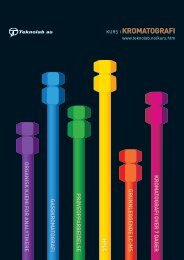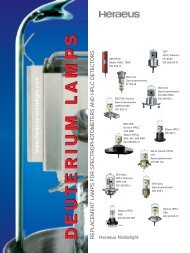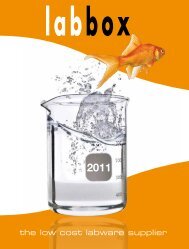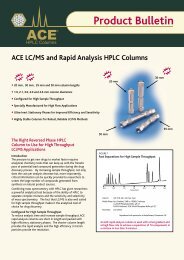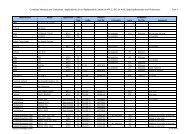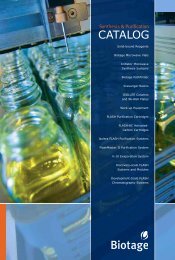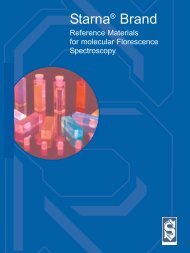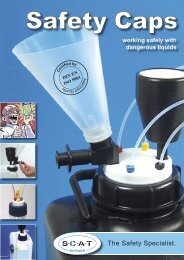PDF catalog - Teknolab AS
PDF catalog - Teknolab AS
PDF catalog - Teknolab AS
Create successful ePaper yourself
Turn your PDF publications into a flip-book with our unique Google optimized e-Paper software.
GUIDE QUICKSTART GUIDE TO SPE<br />
Sorbent Conditioning Equilibration Sample pH<br />
Polar silica-based sorbents, see page 72-79<br />
Interference<br />
Elution<br />
Analyte Elution<br />
ISOLUTE SI, NH2,<br />
CN, DIOL, PSA<br />
Non-polar solvent<br />
e.g. hexane<br />
(preferably the<br />
same solvent as<br />
the sample).<br />
N/A N/A Non-polar solvent<br />
which may contain<br />
a low concentration<br />
of a polar<br />
modifier that will<br />
not elute the<br />
analyte (e.g.<br />
hexane and ethyl<br />
acetate or isopropanol).<br />
Semi-polar solvent<br />
mixture e.g.<br />
hexane:ethyl acetate.<br />
For a non-selective<br />
elution use a polar<br />
solvent such as<br />
methanol.<br />
Ion exchange silica-based sorbents, see page 60-71<br />
SCX-2<br />
Strong cation<br />
exchange.<br />
Methanol or<br />
Acetonitrile.<br />
20-50 mM buffer,<br />
the same pH as<br />
the sample.<br />
At least 2 pH<br />
units below<br />
the pK of<br />
the analyte.<br />
Maintain the same<br />
pH as the sample<br />
and evaluate the<br />
addition of 20-40<br />
% methanol to<br />
elute non-polar<br />
interferences.<br />
% methanol can<br />
be increased for<br />
additional extract<br />
cleanliness. Check<br />
for analyte breakthough.<br />
Elute with buffer at least<br />
2 pH units above the pK<br />
of the basic analyte.<br />
Alternatively use high<br />
ionic strength buffer<br />
(>0.1 M). Elution with<br />
methanol containing 2-5<br />
% ammonia or other<br />
volatile base is common.<br />
SCX-3<br />
Strong cation<br />
exchange with<br />
significant nonpolar<br />
secondary<br />
interactions<br />
Methanol or<br />
Acetonitrile.<br />
20-50 mM buffer,<br />
the same pH as<br />
the sample<br />
At least 2 pH<br />
units below<br />
the pK of<br />
the analyte.<br />
Maintain the same<br />
pH as the sample<br />
and evaluate the<br />
addition of 20-70<br />
% methanol to<br />
elute non-polar<br />
interferences.<br />
% methanol can<br />
be increased for<br />
additional extract<br />
cleanliness. Check<br />
for analyte<br />
breakthough.<br />
Elute with buffer at least<br />
2 pH units above the pK<br />
of the basic analyte.<br />
This should contain at<br />
least 25-50 % organic<br />
solvent to overcome<br />
secondary interactions.<br />
Alternatively use high<br />
ionic strength buffer<br />
(>0.1 M). Elution with<br />
methanol containing 2-5<br />
% ammonia or other<br />
volatile base is common.<br />
CBA<br />
Weak cation<br />
exchange<br />
(sorbent pK 4.8)<br />
Methanol or<br />
Acetonitrile.<br />
20-50 mM buffer,<br />
the same pH as<br />
the sample.<br />
pH≥6.8 and<br />
2 pH units<br />
below the<br />
analyte pK.<br />
Maintain the same<br />
pH as the sample<br />
and evaluate the<br />
addition of 20-50<br />
% methanol to<br />
elute non-polar<br />
interferences.<br />
Buffer at pH 0.1M), or acidified solvent.<br />
PE-AX<br />
Strong anion<br />
exchange (acetate<br />
counter ion)<br />
Methanol or<br />
Acetonitrile.<br />
20-50 mM buffer,<br />
the same pH as<br />
the sample.<br />
Acetate, formate<br />
or hydroxide<br />
buffers are recommended.<br />
At least 2 pH<br />
units above<br />
the pK of<br />
the analyte.<br />
Maintain the same<br />
pH as the sample<br />
and evaluate the<br />
addition of 20-50<br />
% methanol to<br />
elute non-polar<br />
interferences.<br />
Elute with buffer at least<br />
2 pH units below the pK<br />
of the acidic analyte.<br />
Alternatively use high<br />
ionic strength buffer<br />
(>0.1M), or acidified<br />
methanol.<br />
SAX<br />
Strong anion<br />
exchange (chloride<br />
counter ion)<br />
Methanol or<br />
Acetonitrile.<br />
20-50 mM buffer,<br />
the same pH as<br />
the sample<br />
At least 2 pH<br />
units above<br />
the pK of<br />
the analyte.<br />
Maintain the same<br />
pH as the sample<br />
and evaluate the<br />
addition of 20-50<br />
% methanol to<br />
elute non-polar<br />
interferences.<br />
Elute with buffer at least<br />
2 pH units below the pK<br />
of the acidic analyte.<br />
Evaluate addition of 10<br />
% methanol to reduce<br />
elution volume.<br />
Alternatively use high<br />
ionic strength buffer<br />
(>0.1M), or acidified<br />
methanol.<br />
NH2<br />
Weak anion<br />
exchange<br />
(sorbent pK 9.8)<br />
Methanol or<br />
Acetonitrile.<br />
20-50 mM buffer,<br />
the same pH as<br />
the sample<br />
≤7.8 and 2<br />
pH units<br />
above the<br />
analyte pK.<br />
Maintain the same<br />
pH as the sample<br />
and evaluate the<br />
addition of 20-50<br />
% methanol to<br />
elute non-polar<br />
interferences.<br />
Elute with buffer or<br />
methanol at pH>11.8 to<br />
eliminate the charge on<br />
the sorbent. Alternatively<br />
use high ionic strength<br />
buffer (>0.1M), or acidified<br />
methanol.<br />
149




